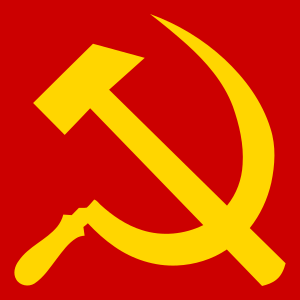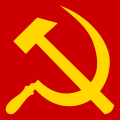Communism facts for kids

Communism is a big idea about how society, money, and government should work. Its main goal is to create a world where factories and farms are shared by everyone. In this kind of society, there would be no rulers and no money.
Communist thinkers believe that society should be "classless" and "stateless." This means no rich or poor groups, and no need for a government to control everything. They think this can happen if regular people take power from the "bourgeoisie." The bourgeoisie are the ruling class who own the factories and farms. Instead, workers would control how things are made and grown.
Communism isn't against individuals. But it does say that decisions should benefit everyone in the country, not just a few people.
Since 1992, five countries have officially followed communist ideas. Four of them, Vietnam, China, Cuba, and Laos, follow different forms of Marxism-Leninism. The fifth, North Korea, now follows an idea called Juche. North Korea used to call itself Marxist-Leninist before 1991. Many other countries stopped being Marxist around that time. This was because many people felt it had failed. Often, Marxist governments led to one-person rule, widespread poverty, money problems, and fighting. Examples include the Soviet Union and Yugoslavia.
Some important people who helped develop communist ideas include Karl Marx, Friedrich Engels, Joseph Stalin, Mao Zedong, Vladimir Lenin, and Leon Trotsky.
Contents
History of Communism
In 1848, Karl Marx and Friedrich Engels wrote a short book called The Communist Manifesto. This book explained the basic ideas of communism. Many socialists and communists still use it to understand politics and money. Even people who don't agree with it often read it.
Karl Marx believed that for society to become communist, there would be a time of change. During this time, workers would run society. Marx was very interested in the Paris Commune of 1870. This was when workers in Paris ran the city after the French army was defeated. He thought this real-life example was very important.
Many groups liked Marx's ideas. By the early 1900s, a worldwide movement called Social Democracy grew. It was inspired by his ideas. They believed that workers in different countries had more in common with each other than with their own bosses. In 1917, Vladimir Lenin and Leon Trotsky led a Russian group called the Bolsheviks. They started the October Revolution. They removed the temporary government in Russia and created the Union of Soviet Socialist Republics, also known as the Soviet Union or USSR.
The Soviet Union was the first country to claim it had a workers' state. But it never truly became communist in the way Marx and Engels described.
During the 1900s, many people tried to create workers' states. In the late 1940s, China also had a revolution. They formed a new government with Mao Zedong as its leader. In 1959, the island of Cuba had a revolution. They created a new government led by Fidel Castro. At one point, many countries were trying to build communism. But communist party governments often didn't use democracy. This is a very important part of socialism and communism. Because of this, the governments became separated from the people. This made communism difficult and led to disagreements between countries.
By the 1960s, about one-third of the world had moved away from capitalism. They were trying to build communism. Most of these countries followed the Soviet Union's example. Some followed China's example. The other two-thirds of the world still lived under capitalism. This led to a worldwide split between capitalist and communist countries. This was called the "Cold War." It wasn't fought with weapons or armies. Instead, it was a battle of ideas. However, it could have turned into a big war. In the 1980s, the United States and the Soviet Union competed to have the biggest armies and most dangerous weapons. This was called the "Arms Race." President Ronald Reagan called communist countries like the Soviet Union the "Evil Empire." He disagreed with their ideas.
Since 1989, when the Berlin Wall was torn down, most countries that were communist have returned to capitalism. Communism now has much less power around the world. In 1991, the Soviet Union broke up. However, about one-fifth of the world's people still live in countries controlled by a communist party. Most of these people are in China. Other countries include Cuba, Vietnam, Laos, and North Korea. There are also communist groups in Latin America and South Africa.
Different Ideas in Communism
Many people have written their own ideas about communism. Vladimir Lenin of Russia thought there needed to be a group of dedicated revolutionaries, called a "vanguard." This group would lead a worldwide socialist revolution to create a communist society everywhere. Leon Trotsky, also from Russia, believed that socialism had to be international. He thought it wasn't important to make it happen first in Russia. He also didn't like Joseph Stalin, who became the leader of the USSR after Lenin died in 1924. Stalin forced Trotsky to leave the Soviet Union in 1928. Trotsky was later killed in 1940. This worried many people. Many communists argued about whose ideas were right.
Mao Zedong of China thought that other groups of people would be important for the revolution in China and other developing countries. This was because the working classes in these countries were small. Mao's ideas are often called Maoism. After Stalin died in 1953, Mao saw himself as the leader of worldwide communism until he died in 1976. Today, the Chinese government is still ruled by the Communist Party. But they actually have a "mixed economy." This means they use many ideas from capitalism. The government in China today does not follow Maoism. However, a few revolutionaries in other countries like India and Nepal still like his ideas. They try to use them in their own countries.
How the Term "Communism" is Used
The word "communism" isn't always a very exact way to describe left-wing political groups. Many political parties that call themselves "communist" might actually be more "reformist." This means they support slow changes instead of a revolution. Some parties calling themselves "socialists" might even be more revolutionary. Many communist parties in Latin America have lost members. This is because they do different things once they get into power than what they promised. For example, in Chile, from 1970-1973, the Communist Party of Chile was more reformist than the Socialist Party of Chile.
Many communist parties use a "reformist" plan. They say working-class people aren't organized enough to make big changes yet. So, they put forward candidates who will be elected fairly. Once communists are elected to parliament or the Senate, they will fight for the working class. This, they believe, will allow working-class people to change their capitalist society into a socialist one.
Symbols and Culture
The color red is a common symbol of communism around the world. A red five-pointed star also sometimes stands for communism. The hammer and sickle is a very well-known symbol of communism. It was on the flags of many communist countries, like the Soviet Union. Some communists also use pictures of famous communists from history, like Karl Marx, Vladimir Lenin, and Mao Zedong, as symbols of the whole idea of communism.
A song called The Internationale was the international song of communism. It has the same music everywhere, but the words are translated into many languages. The Russian version was the national song of the Soviet Union from 1922 until 1944.
The sickle in the Soviet Union's flag shows the hard work of farmers. The hammer in the flag represents the hard work of factory workers. Both of them crossing shows their support for each other.
There is also a special kind of art and architecture found in many communist and former communist countries. Paintings done in the style of socialist realism were often made to show a perfect version of a country's people and political leader. Art in this style, like plays, movies, novels, and paintings, showed hard-working, happy, and well-fed factory workers and farmers. Movies, plays, and novels often told stories about workers or soldiers who gave up things for their country's good. Paintings often showed heroic pictures of the leader, or huge fields of wheat. Stalinist architecture was meant to show the power and glory of the state and its leader. Some people who are not communists also enjoy this kind of art.
Notable People
- Fidel Castro
- Nicolae Ceaușescu
- Mikhail Gorbachev
- Che Guevara
- Erich Honecker
- Vladimir Lenin
- Karl Marx
- Friedrich Engels
- Joseph Stalin
- Ho Chi Minh
- Mao Zedong
- Leon Trotsky
- Josip Broz Tito
- Kim Jong Un
- Deng Xiaoping
Related pages
Images for kids
-
The Hammer and sickle, a symbol of communism and workers' power
-
Thomas More, whose Utopia described a society where property was shared
-
A poster from the Communist Party of Vietnam in Hanoi
-
A monument to Karl Marx (left) and Friedrich Engels (right) in Shanghai
-
A statue of Vladimir Lenin in Kolkata, India
-
A 1942 picture of Joseph Stalin, a long-serving leader of the Soviet Union
-
A detail from a fresco showing Leon Trotsky, Friedrich Engels, and Karl Marx
-
Enrico Berlinguer, a leader of the Italian Communist Party
-
Rosa Luxemburg, an important communist thinker
-
Peter Kropotkin, a main thinker of anarcho-communism
See also
 In Spanish: Comunismo para niños
In Spanish: Comunismo para niños















